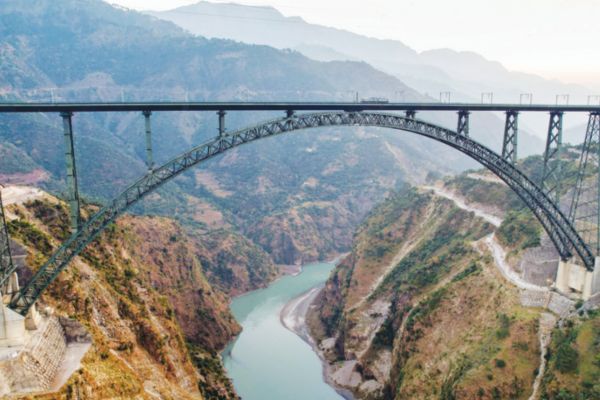
Chenab Bridge Inaugurated: India’s Greatest Engineering Marvel Unveiled

 :
| Updated On: 06-Jun-2025 @ 2:37 pm
:
| Updated On: 06-Jun-2025 @ 2:37 pmSHARE
The Chenab Bridge, inaugurated by Prime Minister Narendra Modi, stands as a landmark achievement in Indian infrastructure and engineering. Located in Jammu and Kashmir, it is a crucial part of the 272-km Udhampur-Srinagar-Baramulla Railway Link (USBRL) project, which aims to enhance connectivity in the region and marks a historic milestone for Indian Railways. Alongside this bridge, the Anji Khad Bridge—India’s first cable-stayed rail bridge—was also included in the broader USBRL project.
The Chenab Bridge is now the world’s highest railway bridge, with a height of 359 metres, making it 35 metres taller than the Eiffel Tower in Paris and nearly five times taller than the Qutub Minar. Its total length is 1.31 km, and it was constructed using 28,660 megatonnes of steel, allowing it to endure extreme climatic conditions—from sub-zero temperatures to heat levels reaching 40°C. Its ability to withstand wind speeds up to 266 km/h and strong seismic activity highlights its robust design.
The bridge's construction began in 2003 and took two decades to complete, largely due to the difficult topography of the Himalayan region and the remote location. Transporting construction machinery and materials through rugged terrain posed significant logistical challenges. The government recognized the Chenab Bridge as “the biggest civil-engineering challenge faced by any railway project in India in recent history.”
What makes the design truly exceptional is its built-in safety resilience. The structure allows trains to pass at low speeds even if one of the piers—the vertical supports—gets damaged, ensuring train movement continuity and passenger safety under unforeseen circumstances. Its construction involved years of research, technical consultation, and innovation, all tailored to suit the Himalayan environment.
Alongside this engineering marvel, PM Modi also inaugurated Vande Bharat Express train services between Katra and Srinagar, which are expected to boost tourism and economic activity in the region. These trains are specially designed to function in the extreme cold of Jammu and Kashmir. Equipped with advanced heating systems, these trains can operate even in sub-zero temperatures, ensuring seamless service during harsh winters.
Key features of these special Vande Bharat trains include silicon heating pads under water systems to prevent freezing, bio-toilet tanks, auto-drain mechanisms, and an anti-spall protective layer on windows and windshields that shields passengers and drivers from high-speed flying debris like ice or stones. The trains are also fitted with modern technologies to maintain comfort, safety, and operational reliability under extreme weather conditions.
Together, the Chenab Bridge and the Kashmir-bound Vande Bharat Express trains represent a technological leap in Indian transportation infrastructure. These projects not only demonstrate India’s engineering capabilities but also contribute to the integration and development of one of the country’s most remote and strategically significant regions.
Contact Us
House. No. : 163, Second Floor Haridev Rd, near Puberun Path, Hatigaon,Guwahati, Assam 781038.
E-mail : assaminkcontact@gmail.com
Contact : +91 8811887662
Enquiry
×
Reporter Login
×